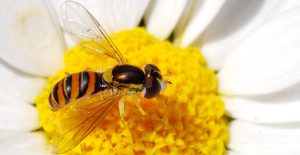Plants and pollinators use electric fields to find each other
By James Ashworth
Hoverflies have been shown to be able to sense the weak electric fields of plants.
Pollinators and flowers attract can each other with electric fields to maximize the benefits for both, researchers have found.
Some insects, such as hoverflies, are able to detect flowers using these electric fields, while some flowers can use them to sense pollinators and release targeted bursts of scent to draw more of them in.
The findings demonstrate another way in which flowers and pollinators have evolved together. With pollinators around the world under threat from a range of factors, this research can help scientists better understand the roles they play.
‘Insects are the dominant pollinators in agroecosystems, providing pollination services for many of our crops,’ says Dr József Vuts, author of one of the studies. ‘The better we understand pollinator-plant interactions, the better we can preserve pollinating insects and ensure food security.’
Pollinators and plants have evolved together for millions of years.
Together in electric dreams
Pollinators and plants are locked together in a co-evolutionary cycle, where each adapts in response to changes in the other. They have been doing so for tens of millions of years, with pollinators ranging from generalists like the honeybee to specialists like the yucca-moth. Pollinators get rewards such as nectar, while plants get pollen delivered for reproduction.
While some of the interactions are obvious, such as bright colours, pungent scents and the complex shapes, there are other adaptations that aren’t as perceptible. For example, bees can see a wider range of the light spectrum than us, resulting in flowers looking different under UV light in order to attract them.
Electric fields are another adaptation. The exoskeleton of many insects has been shown to carry positive charges, while flowers are negatively charged. As opposite charges attract, this was believed to help pollen stick to pollinators. But further implications have recently been understood.
Research suggests that bees can sense the weak electric fields generated by plants by the way their hairs are deflected. Plants also temporarily lose their negative charge as they are visited by pollinators, suggesting pollinators may also be able to pick up whether flowers are currently occupied.
While these senses have been suggested as a possibility in pollinators other than bees, little research has been carried out into it. Hoverflies, alongside bumblebees and honeybees, are one of the main pollinators of plants, but their ability to sense electric fields was unknown.
To read the entire article go to; Plants and pollinators use electric fields to find each other | Natural History Museum (nhm.ac.uk)









